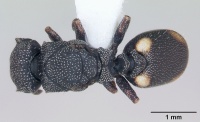Cephalotes maculatus
| Cephalotes maculatus | |
|---|---|

| |
| Scientific classification | |
| Kingdom: | Animalia |
| Phylum: | Arthropoda |
| Class: | Insecta |
| Order: | Hymenoptera |
| Family: | Formicidae |
| Subfamily: | Myrmicinae |
| Tribe: | Attini |
| Genus: | Cephalotes |
| Species group: | pinelii |
| Species: | C. maculatus |
| Binomial name | |
| Cephalotes maculatus (Smith, F., 1876) | |
| Synonyms | |
| |
A common Cephalotes species that is widely distributed and occurs in many habitat types.
Identification
A member of the pinelii clade differing from all the other species of the clade in the worker by the maximum diameter of the eyes greater than 1/3 of the head length, in the soldier, by the flat vertex, in the soldier and in the gyne by the concolour head and pronotum. The workers and soldiers from Mexico, Guatemala, Honduras, Nicaragua and Costa Rica (in part) are larger and with denser foveae on the head than the southern representatives of the species. This geographic trend does not appear in Costa Rican specimens from Alajuela, Orotina, Turrialba and Hamburg Farm. (de Andrade and Baroni Urbani 1999)
Keys including this Species
Distribution
Mexico, Guatemala, Honduras, Nicaragua, Costa Rica, Panama, Colombia, Trinidad, Guyana, French Guiana, Brazil, Ecuador, Peru, Bolivia, Argentina and Paraguay.
Latitudinal Distribution Pattern
Latitudinal Range: 23.31611389° to -34.6°.
| North Temperate |
North Subtropical |
Tropical | South Subtropical |
South Temperate |
- Source: AntMaps
Distribution based on Regional Taxon Lists
Neotropical Region: Argentina, Bolivia, Brazil (type locality), Colombia, Costa Rica, Ecuador, French Guiana, Guatemala, Guyana, Honduras, Mexico, Nicaragua, Panama, Paraguay, Peru, Trinidad and Tobago, Venezuela.
Distribution based on AntMaps
Distribution based on AntWeb specimens
Check data from AntWeb
Countries Occupied
| Number of countries occupied by this species based on AntWiki Regional Taxon Lists. In general, fewer countries occupied indicates a narrower range, while more countries indicates a more widespread species. |

|
Estimated Abundance
| Relative abundance based on number of AntMaps records per species (this species within the purple bar). Fewer records (to the left) indicates a less abundant/encountered species while more records (to the right) indicates more abundant/encountered species. |

|
Biology
Longino found a colony in a one day old treefall in Corcovado National Park: A nest was in the center of a live stem, stem dia. 14mm, at the very top of the tree. A single round hole extended perpendicularly from the surface to a central cavity which extended in both directions. The cavity was 5.5cm long and 3mm wide. The nest contained only a major, one mature worker, one callow worker, and 7 individual brood, ranging from a very small larva to a pupa.
|
Castes
Worker
Images from AntWeb
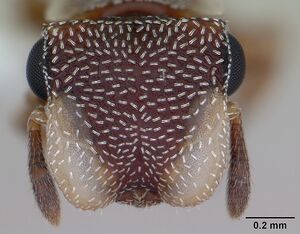 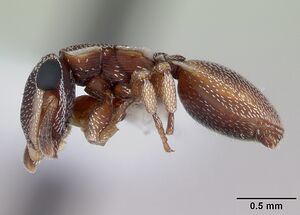  
| |
| Worker. Specimen code casent0173688. Photographer April Nobile, uploaded by California Academy of Sciences. | Owned by ALWC, Alex L. Wild Collection. |
Soldier
Images from AntWeb
 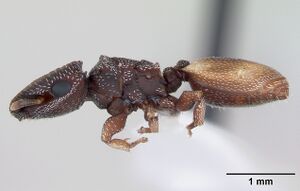  
| |
| Worker. Specimen code casent0173689. Photographer April Nobile, uploaded by California Academy of Sciences. | Owned by ALWC, Alex L. Wild Collection. |
Male
Images from AntWeb
  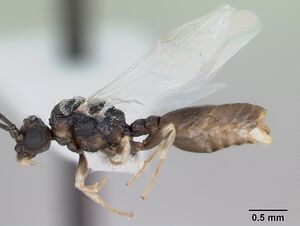   
| |
| Male (alate). Specimen code casent0173690. Photographer April Nobile, uploaded by California Academy of Sciences. | Owned by ALWC, Alex L. Wild Collection. |
Nomenclature
The following information is derived from Barry Bolton's Online Catalogue of the Ants of the World.
- maculatus. Cryptocerus maculatus Smith, F. 1876d: 607, pl. 11, fig. 6 (q.) BRAZIL (Bahia).
- Type-material: holotype queen.
- Type-locality: Brazil: Bahia (no further data).
- Type-depository: BMNH.
- [Misspelled as masculatus by Mann, 1922: 34.]
- Emery, 1894c: 208 (s.w.); Forel, 1905b: 158 (m.); Wheeler, G.C. & Wheeler, J. 1954b: 156 (l.).
- Combination in Paracryptocerus (Harnedia): Kempf, 1952: 18; Kempf, 1958a: 18;
- combination in Zacryptocerus: Hespenheide, 1986: 395;
- combination in Cephalotes: De Andrade & Baroni Urbani, 1999: 375.
- Status as species: Dalla Torre, 1893: 143; Emery, 1894c: 208; Forel, 1895b: 133; Forel, 1899c: 50; Forel, 1905b: 158; Forel, 1911e: 258; Forel, 1912e: 201; Forel, 1914d: 281; Bruch, 1915: 530; Wheeler, W.M. 1916c: 11; Mann, 1916: 450; Crawley, 1916b: 372; Wheeler, W.M. 1918b: 26; Mann, 1922: 34; Wheeler, W.M. 1922c: 11; Emery, 1924d: 311; Borgmeier, 1927c: 118; Menozzi, 1927c: 268; Menozzi, 1927d: 336; Kempf, 1952: 18 (redescription); Kusnezov, 1953b: 338; Kempf, 1958a: 18; Kempf, 1972a: 178; Kempf, 1974a: 73 (in key); Brandão, 1991: 387; Bolton, 1995b: 426; De Andrade & Baroni Urbani, 1999: 375 (redescription); Wild, 2007b: 32; Branstetter & Sáenz, 2012: 257; Bezděčková, et al. 2015: 116; Sandoval-Gómez & Sánchez-Restrepo, 2019: 912.
- Senior synonym of magdalenensis: De Andrade & Baroni Urbani, 1999: 375.
- Senior synonym of nanus: Kempf, 1952: 19; Kempf, 1972a: 178; Brandão, 1991: 387; Bolton, 1995b: 426; De Andrade & Baroni Urbani, 1999: 375.
- Distribution: Argentina, Bolivia, Brazil, Colombia, Costa Rica, Ecuador, French Guiana, Guatemala, Guyana, Honduras, Mexico, Nicaragua, Panama, Paraguay, Peru, Trinidad, Venezuela.
- magdalenensis. Cryptocerus grandinosus r. magdalenensis Forel, 1899b: 303 (w.) COLOMBIA.
- Type-material: holotype worker.
- Type-locality: Colombia: (no further data) (Princess Therese of Bavaria).
- [Note: Forel, 1899d: 275, adds the data: Colombia: Magdalena, San Pablo (T. von Bayern).]
- Type-depository: ZSBS.
- [Also described as new by Forel, 1899d: 275.]
- Subspecies of grandinosus: Emery, 1924d: 310.
- Junior synonym of grandinosus: Kempf, 1952: 11; Kempf, 1972a: 177; Brandão, 1991: 386; Bolton, 1995b: 426.
- Junior synonym of maculatus: De Andrade & Baroni Urbani, 1999: 375.
- nanus. Cryptocerus maculatus r. nanus Forel, 1912e: 202 (w.) TRINIDAD.
- Type-material: holotype worker.
- Type-locality: Trinidad: (no further data) (A. Forel).
- Type-depository: MHNG.
- Subspecies of maculatus: Wheeler, W.M. 1922c: 11; Emery, 1924d: 311.
- Junior synonym of maculatus: Kempf, 1952: 19; Kempf, 1972a: 178; Brandão, 1991: 387; Bolton, 1995b: 426; De Andrade & Baroni Urbani, 1999: 375.
Description
Worker
Kempf (1952) - Length 2.6-3.0 mm. Fuscous reddish-brown to black. Outer face of tibiae pale brown. Rest of legs ferruginous. Frontal carinae and membranaceous borders of thorax, peduncle and gaster whitish.
Head subquadrate, longer than wide, the median head length as long as, or longer than, the interocular width. Edge of lateral border smooth. Sides of head slightly convex and upturned above eyes. Occipital corner little or not membranaceous, sharply angulate to subdentate. Occipital border straight. Greatest diameter of eyes almost one third of maximum head length.
Thorax longer than wide. Membranaceous border of pronotum and epinotum broad, not forming a reentrant angle at the mesonotum. Shoulders subacutely angulate. Sides of mesonotum with a small projecting tooth, the tip of which is often membranaceous. Mesoepinotal suture distinct. Declivous face of epinotum differentiated from the basal face. Dorsum of hind femora longitudinally marginate, not crested, on the apical half; no crest on the lower face.
Peduncular segments subequal in width to the width of the cpinotum, with conspicuous lateral membranaceous appendages. Anterior face of petiole usually notched mesally.
Gaster longer than wide, proportionally shorter than in pinclii and grandinosus. Anterolateral membranaceous border rounded.
Subopaque, finely shagreened. Dorsum of head, thorax and peduncle with small squamiferous foveolae. Dorsum of thorax, especially on the region of the mesoepinotal suture usually with distinct longitudinal rugosities. Sides of thorax, except the laterotergite of the pronotum, and the declivous face longitudinally striated. Scale-like hair small, shiny, appressed. No erect setae on the first gastral tergite."
de Andrade and Baroni Urbani (1999) - Measurements (in mm) and indices: TL 2.81-3.93; HL 0.70-0.92; HW 0.78-1.00; EL 0.25-0.31; PW 0.72-0.96; PeW 0.50-0.59; PpW 0.48-0.56; HBaL 0.18-0.26; HBaW 0.06-0.09; CI 108.7-111.4; PI 104.2-108.3; PPeI 144.0-162.7; PPpI 150.0-171.4; HBaI 33.3-34.6.
Soldier
Kempf (1952) - Length 3.9-4.2 mm. Color as in worker. Head disc uniformly fuscous reddish-brown to black, the portion overlying the antennal scrobe not membranaceous nor differently colored. First gastral tergite, especially in larger specimens, with lighter yellowish-brown spots, one toward each corner, the anterior pair often fusing mesally into a transverse band, the posterior pair usually small, somewhat removed from the posterior border.
Head slightly longer than wide; disc not well rounded, subrectangular, excavate, flat to scarcely convex mesally. Supramandibular excision subsemicircular. Border of disc not glassy nor membranaceous. Occipital border of cephalic disc usually straight and without a pair of small, projecting denticules. Sides of head continuous with the truncate occiput, not separated by a margination or ridge.
Thorax as long as wide across the pronotum. Anterior border of pronotum broadly excised laterad, the shoulders acute and spine-like. Transverse pronotal carina slightly interrupted mesally. Mesonotum much narrower than pronotum, with a projecting, usually angulate lobe on each side. Basal face of epinotum with a small rounded lobe laterally and an upturned tubercular tooth on each posterior corner. Sides of declivous face narrowly crested. Hind femora without a dorsal and ventral crest on the apical half.
Peduncular segments as in worker; the lateral membranaceous appendages less prominent.
Gaster elliptical. The anterolateral lobes rounded, the crests lacking in large soldiers.
Integument opaque, finely shagreened. Head disc coarsely and densely foveolate. The foveolae are much smaller on the dorsum of the thorax and the peduncular segments. Gaster and sides of thorax without any conspicuous foveolae. Scales as in worker, absent on the declivous face.
de Andrade and Baroni Urbani (1999) - Measurements (in mm) and indices: TL 3.76-4.86; HL 0.96-1.20; HW 1.04-1.28; EL 0.28-0.30; PW 1.04-1.32; PeW 0.51-0.64; PpW 0.51-0.68; HBaL 0.24-0.28; HBaW 0.08-0.10; CI 106.7-108.3; PI 97.0-100.0; PPeI 203.9-206.2; PPpI 194.1-203.9; HBaI 33.3-35.7.
Queen
Kempf (1952) - Length 5.6-6.4 mm. Color as in soldier. The four maculae of the first gastral tergite better delimited and usually more prominent than in soldier, yellowish to ferruginous-yellow.
Head elongate, one and one fourth times as long as wide. Supramandibular excision narrow, subsemicircular. Cephalic disc elongate, subrectangular, moderately convex, slightly excavated, but not membranaceous, above the antennal scrobe; the sides subparallel, scarcely curved, often somewhat converging caudad; the edges of the disc scarcely crenulate, very little upturned, forming only a slightly prominent ridge postero-laterally above the occipital lobes.
Thorax elongate. Anterior border of pronotum somewhat excised laterally, not quite as prominent as in soldier. Shoulders acute. Transverse pronotal carina ininterrupted. Lower plate of mesopleura anteriorly with a tooth. Basal face of epinotum with a rounded lateral lobe and a rather sharp tooth on the posterior corner. Hind femora neither crested nor angulate above near the middle.
Peduncular segments massive, with the lateral projections scarcely membranaceous. Petiole with a lateral small tooth, pointing obliquely caudad, the postpctiole with a lateral obliquely truncate lobe, similar to that of soldier.
Gaster with the anterior border deeply emarginate, the anterolateral lobes rounded to subangulate.
Sculpture and pilosity as in soldier. The scales of the gaster are glistening and minute.
Wings hyaline. The venation of the fore wing of the usual pattern: a close and appendiculate marginal cell; transverse cubital vein present.
de Andrade and Baroni Urbani (1999) - Measurements (in mm) and indices: TL 5.64-6.84; HL 1.20-1.28; HW 1.08-1.22; EL 0.29-0.32; PW 1.06-1.14; PeW 0.44-0.51; PpW 0.60-0.68; HBaL 0.33-0.35; HBaW 0.10-0.11; CI 90.0-95.3; PI 101.9-107.0; PPeI 223.5-240.9; PPpI 167.6-176.7; HBaI 30.3-31.4.
Male
de Andrade and Baroni Urbani (1999), translation of the description of Menozzi (1927) - "Black, antennae, tibiae and tarsi ferruginous. Abundant pilosity over the whole body; pubescence limited to the antennae, tibiae and tarsi. Head much wider than long, opaque, striate-punctate, except a transversal part between the eye and the frontal lamina, smooth and shining. Mandibles small, finely punctate, with the masticatory border armed with several very small teeth. Clypeus equally very small and strongly convex posteriorly. Antennae with very short scape; the first funicular joint one third of the second in length, the latter being the longest; the last joints twice as long as broad, and, beginning from the tenth, they broaden gradually up to the last, forming a club. Thorax with pronotum and mesonotum sculptured as the head but the striae constitute the dominant pattern, particularly on their sides; scutellum simply punctate or, rarely, with two or three striae; metanotum and epinotum with visible rugae more or less curved on the dorsum, markedly straight on the sides. Mesonotum with deep Mayrian furrows. Basal face of the epinotum as long as the declivous one to which it is joined by an obtuse angle.
Petiole punctate, subquadrate and slightly marginate on the sides; postpetiole nearly shining, finely reticulate, slightly larger than the petiolar node, equally marginate on the sides which bear two small tubercles anteriorly. Gaster with sculpture similar to the one of the postpetiole, with the basal segment pyriform and occupying more than half of the whole gaster. Genitalia testaceous, with stipes broad and distally hairy; volsella terminating in a long hook with the lacinia built as a short lobe, partly concealed by the volsella itself. Wings hyaline with iridescent reflexes; pterostigma and veins testaceous; one cubital and one closed, not appendiculate radial cell, at least in the six males available to me. Length 5.2-5.8 mm.
de Andrade and Baroni Urbani (1999) - Measurements (in mm) and indices: TL 3.31-4.41; HL 0.54-0.65; HW 0.67-0.82; EL 0.31-0.38; PW 0.54-0.68; PeW 0.27-0.33; PpW 0.25-0.32; HBaL 0.29-0.31; HBaW 0.05-0.06; CI 124.1-126.1; PI 120.6-124.1; PPeI 200.0-206.1; PPpI 212.5-216.0; HBaI 17.2-20.0.
Type Material
- Cryptocerus maculatus: Holotype, queen, Brazil, The Natural History Museum; see De Andrade & Baroni Urbani (1999).
de Andrade and Baroni Urbani (1999):
Gyne. Type locality: Salvador (Bahia, Brazil). Type material: Holotype gyne labelled "Bahia" in The Natural History Museum, examined.
Cryptocerus grandinosis magdalenensis. Worker. Type locality: Colombia (San Pablo, Magdalena R., specified by Forel, 1899 c: 275). Type material: holotype worker labelled "Cr. grandinosus r. magdalenensis, For., type, San Pablo and Magdalena, Colombie”, in Zoologische Staatssammlung, Munich (examined).
Cryptocerus maculatus nanus. Worker. Type locality: Trinidad (savannah). Type material: 1 worker labelled: "Cr. maculatus Sm., R. nanus, type Forel, Savanne, Trinidad (Forel)", in Musee d'Histoire Naturelle Genève, examined.
References
- de Andrade, M. L.; Baroni Urbani, C. 1999. Diversity and adaptation in the ant genus Cephalotes, past and present. Stuttgarter Beitrage zur Naturkunde Series B (Geolgie and Palaontologie). 271:1-889. (page 375, Combination in Cephalotes, page 375, Senior synonym of magdalenensis)
- Adams, R.M.M., Wells, R.L., Yanoviak, S.P., Frost, C.J., Fox, E.G.P. 2020. Interspecific Eavesdropping on Ant Chemical Communication. Frontiers in Ecology and Evolution 8. (doi:10.3389/fevo.2020.00024).
- Albuquerque, E., Prado, L., Andrade-Silva, J., Siqueira, E., Sampaio, K., Alves, D., Brandão, C., Andrade, P., Feitosa, R., Koch, E., Delabie, J., Fernandes, I., Baccaro, F., Souza, J., Almeida, R., Silva, R. 2021. Ants of the State of Pará, Brazil: a historical and comprehensive dataset of a key biodiversity hotspot in the Amazon Basin. Zootaxa 5001, 1–83 (doi:10.11646/zootaxa.5001.1.1).
- Emery, C. 1894d. Studi sulle formiche della fauna neotropica. VI-XVI. Bull. Soc. Entomol. Ital. 26: 137-241 (page 208, soldier, worker described)
- Forel, A. 1905e. Miscellanea myrmécologiques II (1905). Ann. Soc. Entomol. Belg. 49: 155-185 (page 158, male described)
- Forel, A. 1911g. Die Ameisen des K. Zoologischen Museums in München. Sitzungsber. Math.-Phys. Kl. K. Bayer. Akad. Wiss. Münch. 11: 249-303 (page 258, see also)
- Franco, W., Ladino, N., Delabie, J.H.C., Dejean, A., Orivel, J., Fichaux, M., Groc, S., Leponce, M., Feitosa, R.M. 2019. First checklist of the ants (Hymenoptera: Formicidae) of French Guiana. Zootaxa 4674, 509–543 (doi:10.11646/zootaxa.4674.5.2).
- Hespenheide, H.A. 1986. Mimicry of ants of the genus Zacryptocerus. J. N. Y. Entomol. Soc. 94: 394-408 (page 395, Combination in Zacryptocerus)
- Kempf, W. W. 1952. A synopsis of the pinelii-complex in the genus Paracryptocerus (Hym. Formicidae). Stud. Entomol. 1: 1-30 (page 18, Combination in Paracryptocerus (Harnedia); page 19, Senior synonym of nanus, and material of the unavailable name cearensis referred here.)
- Ladino, N., Feitosa, R.M. 2022. Ants (Hymenoptera: Formicidae) of the Parque Estadual São Camilo, an isolated Atlantic Forest remnant in western Paraná, Brazil. ZOOLOGIA 39: e22001 (doi:10.1590/S1984-4689.v39.e22001).
- Melo, T.S., Koch, E.B.A., Andrade, A.R.S., Travassos, M.L.O., Peres, M.C.L., Delabie, J.H.C. 2021. Ants (Hymenoptera: Formicidae) in different green areas in the metropolitan region of Salvador, Bahia state, Brazil. Brazilian Journal of Biology 82, e236269 (doi:10.1590/1519-6984.236269).
- Menozzi, C. 1927d. Formiche raccolte dal Sig. H. Schmidt nei dintorni di San José di Costa Rica (Schluss). Entomol. Mitt. 16: 336-345 (page 336, see also)
- Oliveira, A.M., Powell, S., Feitosa, R.M. 2021. A taxonomic study of the Brazilian turtle ants (Formicidae: Myrmicinae: Cephalotes). Revista Brasileira de Entomologia 65, e20210028 (doi:10.1590/1806-9665-rbent-2021-0028).
- Smith, F. 1876d. Descriptions of new species of Cryptoceridae, belonging to the genera Cryptocerus, Meranoplus, and Cataulacus. Trans. Entomol. Soc. Lond. 1876: 603-612 (page 607, pl. 11, fig. 6 queen described)
- Ulysséa, M.A., Brandão, C.R.F. 2013. Ant species (Hymenoptera, Formicidae) from the seasonally dry tropical forest of northeastern Brazil: a compilation from field surveys in Bahia and literature records. Revista Brasileira de Entomologia 57, 217–224 (doi:10.1590/s0085-56262013005000002).
- Wheeler, G. C.; Wheeler, J. 1954b. The ant larvae of the myrmicine tribes Cataulacini and Cephalotini. J. Wash. Acad. Sci. 44: 149-157 (page 156, larva described)
References based on Global Ant Biodiversity Informatics
- Adams B. J., S. A. Schnitzer, and S. P. Yanoviak. 2019. Connectivity explains local ant community structure in a Neotropical forest canopy: a large-scale experimental approach. Ecology 100(6): e02673.
- Antoniazzi R., R. N. S. L. Garoo, W. Dattilo, S. P. Ribeiro, and F. S. Neves. 2019. Ant species richness and interactions in canopies of two distinct successional stages in a tropical dry forest. The Science of Nature 106: 20
- Bluthgen N., M. Verhaagh, W. Goitia, K. Jaffe, W. Morawetz, and W. Barthlott. 2000. How plants shape the ant community in the Amazonian rainforest canopy: the key role of extrafloral nectaries and homopteran honeydew. Oecologia 125: 229-240.
- Brandao, C.R.F. 1991. Adendos ao catalogo abreviado das formigas da regiao neotropical (Hymenoptera: Formicidae). Rev. Bras. Entomol. 35: 319-412.
- Bruch C. 1915. Suplemento al catálogo de los formícidos argentinos. I. (Addenda et corrigenda). Revista del Museo de La Plata 19: 527-537.
- Castano-Meneses, G., M. Vasquez-Bolanos, J. L. Navarrete-Heredia, G. A. Quiroz-Rocha, and I. Alcala-Martinez. 2015. Avances de Formicidae de Mexico. Universidad Nacional Autonoma de Mexico.
- Chacon de Ulloa P., A. M. Osorio-Garica, R. Achury, and C. Bermudez-Rivas. 2012. Hormigas (Hymenoptera: Formicidae) del Bosque seco tropical (Bs-T) de la cuenca alta del rio Cauca, Colombia. Biota Colombiana 13(2): 165-181.
- Costa-Milanez C. B., F. F. Ribeiro, P. T. A. Castro, J. D. Majer, S. P. Ribeiro. 2015. Effct of fire on ant assemblages in Brazilian Cerrado in areas containing Vereda wetlands. Sociobiology 62(4): 494-505.
- Costa-Milanez C. B., G. Lourenco-Silva, P. T. A. Castro, J. D. Majer, and S. P. Ribeiro. 2014. Are ant assemblages of Brazilian veredas characterised by location or habitat type? Braz. J. Biol. 74(1): 89-99.
- Crawley W. C. 1916. Ants from British Guiana. Ann. Mag. Nat. Hist. 8(17): 366-378.
- Dattilo W. et al. 2019. MEXICO ANTS: incidence and abundance along the Nearctic-Neotropical interface. Ecology https://doi.org/10.1002/ecy.2944
- Dejean, A., S. Durou, I. Olmsted, R.R. Snelling and J. Orivel. 2003. Nest Site Selection by Ants in a Flooded Mexican Mangrove, with Special Reference to the Epiphytic Orchid Myrmecophila christinae. Journal of Tropical Ecology 19(3) :325-331
- Dejean, A., S. Durou, I. Olmsted, R.R. Snelling and J. Orivel. 2003. Nest Site Selection by Ants in a Flooded Mexican Mangrove, with Special Reference to the Epiphytic Orchid Myrmecophila christinae. Journal of Tropical Ecology 19(3):325-331
- Emery C. 1894. Studi sulle formiche della fauna neotropica. VI-XVI. Bullettino della Società Entomologica Italiana 26: 137-241.
- Fernández, F. and S. Sendoya. 2004. Lista de las hormigas neotropicales. Biota Colombiana Volume 5, Number 1.
- Forel A. 1905. Miscellanea myrmécologiques II (1905). Ann. Soc. Entomol. Belg. 49: 155-185.
- Forel A. 1911. Die Ameisen des K. Zoologischen Museums in München. Sitzungsber. Math.-Phys. Kl. K. Bayer. Akad. Wiss. Münch. 11: 249-303.
- Forel A. 1912. Formicides néotropiques. Part II. 3me sous-famille Myrmicinae Lep. (Attini, Dacetii, Cryptocerini). Mémoires de la Société Entomologique de Belgique. 19: 179-209.
- Franco W., N. Ladino, J. H. C. Delabie, A. Dejean, J. Orivel, M. Fichaux, S. Groc, M. Leponce, and R. M. Feitosa. 2019. First checklist of the ants (Hymenoptera: Formicidae) of French Guiana. Zootaxa 4674(5): 509-543.
- Gomes E. C. F., G. T. Ribeiro, T. M. S. Souza, and L. Sousa-Souto. 2014. Ant assemblages (Hymenoptera: Formicidae) in three different stages of forest regeneration in a fragment of Atlantic Forest in Sergipe, Brazil. Sociobiology 61(3): 250-257.
- Gomez V. E. S., and G. Z. González. 2007. Catalogo de Las Hormigas Presentes en El Museo de Historia Natural de la Universidad del Cauca. Popayán : 1-58.
- Groc S., J. H. C. Delabie, F. Fernandez, M. Leponce, J. Orivel, R. Silvestre, Heraldo L. Vasconcelos, and A. Dejean. 2013. Leaf-litter ant communities (Hymenoptera: Formicidae) in a pristine Guianese rainforest: stable functional structure versus high species turnover. Myrmecological News 19: 43-51.
- INBio Collection (via Gbif)
- Kempf W. W. 1952. A synopsis of the pinelii-complex in the genus Paracryptocerus (Hym. Formicidae). Studia Entomologica 1: 1-30.
- Kempf, W.W. 1972. Catalago abreviado das formigas da regiao Neotropical (Hym. Formicidae) Studia Entomologica 15(1-4).
- Kusnezov N. 1953. La fauna mirmecológica de Bolivia. Folia Universitaria. Cochabamba 6: 211-229.
- Kusnezov N. 1978. Hormigas argentinas: clave para su identificación. Miscelánea. Instituto Miguel Lillo 61:1-147 + 28 pl.
- Lattke J. E., and M. Velez, and N. Aguirre. 2016. Survey of ants in dry forests of Southwestern Ecuador (Hymenoptera: Formicidae). Sociobiology 63(3): 909-918.
- Longino J. T. 2013. Ants of Honduras. Consulted on 18 Jan 2013. https://sites.google.com/site/longinollama/reports/ants-of-honduras
- Longino J. T. 2013. Ants of Nicargua. Consulted on 18 Jan 2013. https://sites.google.com/site/longinollama/reports/ants-of-nicaragua
- Longino J. et al. ADMAC project. Accessed on March 24th 2017 at https://sites.google.com/site/admacsite/
- Longino, J.T. 2010. Personal Communication. Longino Collection Database
- Maes, J.-M. and W.P. MacKay. 1993. Catalogo de las hormigas (Hymenoptera: Formicidae) de Nicaragua. Revista Nicaraguense de Entomologia 23.
- Mann W. M. 1916. The Stanford Expedition to Brazil, 1911, John C. Branner, Director. The ants of Brazil. Bulletin of the Museum of Comparative Zoology 60: 399-490
- Maravalhas J., and H. L. Vasconcelos. 2014. Revisiting the pyrodiversitybiodiversity hypothesis: long-term fire regimes and the structure of ant communities in a Neotropical savanna hotspot. Journal of Applied Ecology 51: 1661-1668.
- Menozzi C. 1927. Formiche raccolte dal Sig. H. Schmidt nei dintorni di San José di Costa Rica. Entomologische Mitteilungen. Berlin-Dahlem. 16: 266-277.
- Navarro, E.V. Vergara, H. Echavarria Sanchez, F.J. Serna Cardona. 2007. Hormigas (Hymenoptera: Formicidae) asociadas al arboretum de la Universidad Nacional de Colombia, sede Medellin. Boletín Sociedad Entomológica Aragonesa 40:497-505.
- Neves F. S., K. S. Queiroz-Dantas, W. D. da Rocha, and J. H. C. Delabie. 2013. Ants of Three Adjacent Habitats of a Transition Region Between the Cerrado and Caatinga Biomes: The Effects of Heterogeneity and Variation in Canopy Cover. Neotrop Entomol 42: 258268.
- Pires de Prado L., R. M. Feitosa, S. Pinzon Triana, J. A. Munoz Gutierrez, G. X. Rousseau, R. Alves Silva, G. M. Siqueira, C. L. Caldas dos Santos, F. Veras Silva, T. Sanches Ranzani da Silva, A. Casadei-Ferreira, R. Rosa da Silva, and J. Andrade-Silva. 2019. An overview of the ant fauna (Hymenoptera: Formicidae) of the state of Maranhao, Brazil. Pap. Avulsos Zool. 59: e20195938.
- Siqueira de Castro F., A. B. Gontijo, P. de Tarso Amorim Castro, and S. Pontes Ribeiro. 2012. Annual and Seasonal Changes in the Structure of Litter-Dwelling Ant Assemblages (Hymenoptera: Formicidae) in Atlantic Semideciduous Forests. Psyche doi:10.1155/2012/959715
- Siqueira de Castro F., A. B. Gontijo, W. Duarte da Rocha, and S. Pontes Ribeiro. 2011. As comunidades de formigas de serapilheira nas florestas semidecíduas do Parque Estadual do Rio Doce, Minas Gerais. MG.BIOTA, Belo Horizonte 3(5): 5-24.
- Vasconcelos, H.L., J.M.S. Vilhena, W.E. Magnusson and A.L.K.M. Albernaz. 2006. Long-term effects of forest fragmentation on Amazonian ant communities. Journal of Biogeography 33:1348-1356
- Viana-Silva F. E. C., and C. M. Jacobi. 2012. Myrmecofauna of Ironstone Outcrops: Composition and Diversity. Neotrop Entomol 41: 263271.
- Vásquez-Bolaños M. 2011. Lista de especies de hormigas (Hymenoptera: Formicidae) para México. Dugesiana 18: 95-133
- Wheeler W. M. 1916. Ants collected in British Guiana by the expedition of the American Museum of Natural History during 1911. Bulletin of the American Museum of Natural History 35: 1-14.
- Wheeler W. M. 1918. Ants collected in British Guiana by Mr. C. William Beebe. Journal of the New York Entomological Society 26: 23-28.
- Wheeler W. M. 1922. The ants of Trinidad. American Museum Novitates 45: 1-16.
- Wheeler W. M. 1942. Studies of Neotropical ant-plants and their ants. Bulletin of the Museum of Comparative Zoology 90: 1-262.
- Wild, A. L.. "A catalogue of the ants of Paraguay (Hymenoptera: Formicidae)." Zootaxa 1622 (2007): 1-55.
- de Andrade, M.L. & C. Baroni Urbani. 1999. Diversity and Adaptation in the ant genus Cephalotes, past and present. Stuttgarter Beitrage zur Naturkunde Serie B 271. 893 pages, Stuttgart

